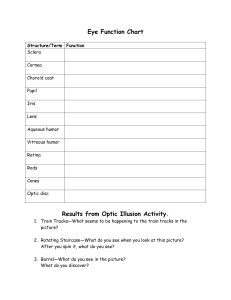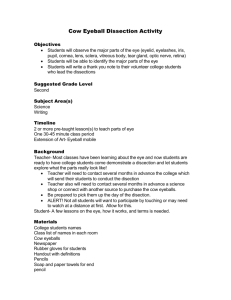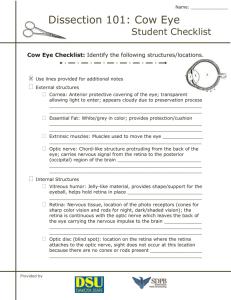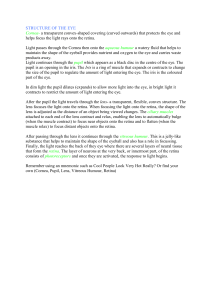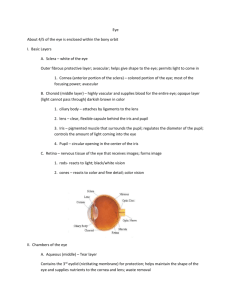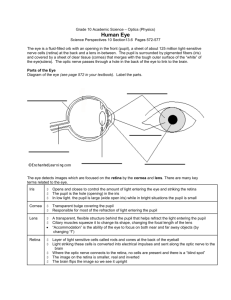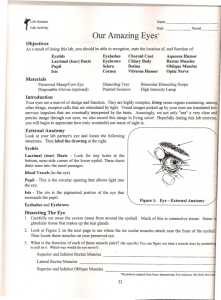EyeDissectionTeacherQuiz
advertisement
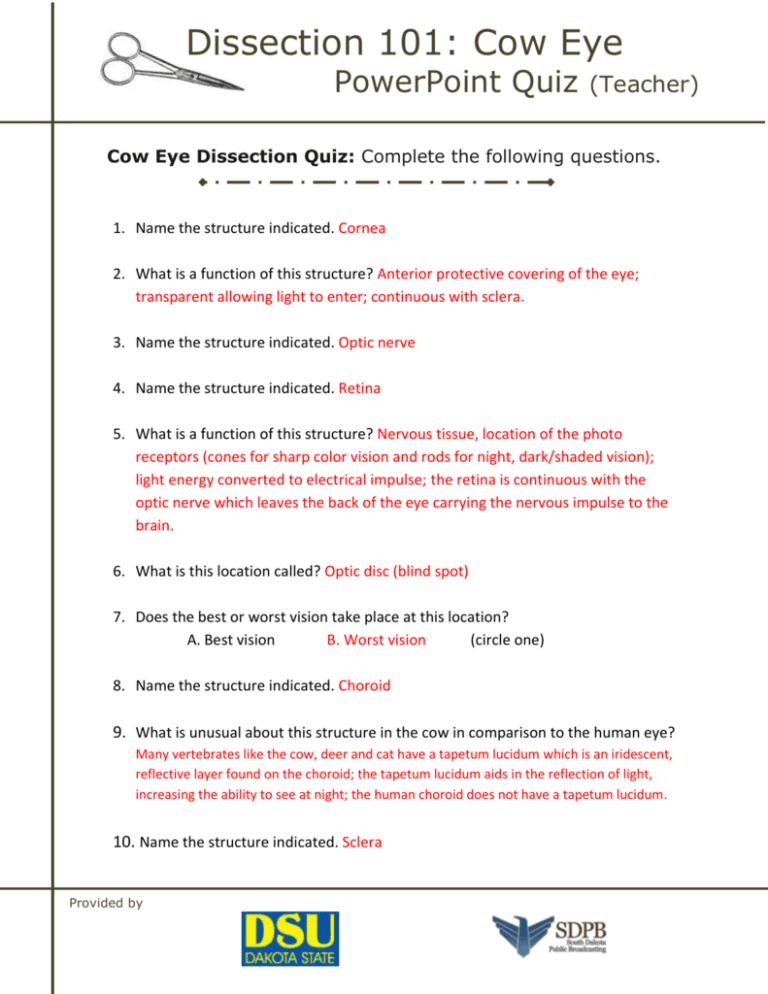
Dissection 101: Cow Eye PowerPoint Quiz (Teacher) Cow Eye Dissection Quiz: Complete the following questions. 1. Name the structure indicated. Cornea 2. What is a function of this structure? Anterior protective covering of the eye; transparent allowing light to enter; continuous with sclera. 3. Name the structure indicated. Optic nerve 4. Name the structure indicated. Retina 5. What is a function of this structure? Nervous tissue, location of the photo receptors (cones for sharp color vision and rods for night, dark/shaded vision); light energy converted to electrical impulse; the retina is continuous with the optic nerve which leaves the back of the eye carrying the nervous impulse to the brain. 6. What is this location called? Optic disc (blind spot) 7. Does the best or worst vision take place at this location? A. Best vision B. Worst vision (circle one) 8. Name the structure indicated. Choroid 9. What is unusual about this structure in the cow in comparison to the human eye? Many vertebrates like the cow, deer and cat have a tapetum lucidum which is an iridescent, reflective layer found on the choroid; the tapetum lucidum aids in the reflection of light, increasing the ability to see at night; the human choroid does not have a tapetum lucidum. 10. Name the structure indicated. Sclera Provided by Dissection 101: Cow Eye PowerPoint Quiz Continue (student) 11. What is a function of this structure? Tough protective outer layer of the eye which gives the eyeball it’s shape; the white part of the human eye; continuous with the transparent cornea. 12. Name the structure indicated. Lens 13. What is a function of this structure? Biconvex structure that focuses light on the retina through a process called accommodation. 14. Name the structure indicated. Iris 15. What is a function of this structure? : Structure of the eye which controls the size of the opening into the eye which is called the pupil. 16. Name the structure (location) indicated. Pupil 17.Describe how these two structures (A & B) work together in response to light intensity. The pupil (B) which is the opening of the eye allows light to enter. The diameter of the opening is controlled by the iris (A). The iris is the structure of the eye which controls the size of the opening into the eye which is called the pupil. The pupil gets larger when the radial muscles of the iris contract in dim light. The circular/sphincter muscles of the iris contract to reduce the size of the pupil for brighter light. 18.Describe the movement of light through the eye from the exterior of the eye to the brain, using the following. (optic nerve, iris, pupil, sclera, cones, rods, cornea, retina, lens and vitreous humor) Use a labeled drawing if it is helpful. Accept reasonable answers; below is an example of a response for light movement through the eye. Light enters the eye through the transparent cornea which is continuous with the sclera. The light travels through an opening called the pupil; the size of the pupil (constricted for brighter light and dilated for dim light) is controlled by muscle contractions of the iris. Light then travels through the lens which focuses the light toward Provided by Dissection 101: Cow Eye PowerPoint Quiz Continue (student) the retina through a process called accommodation. Bulging of the lens, for closer objects, bends the light rays more; thinning of the lens, for distant objects, bends the light rays less. The light travels through the vitreous humor which also bends the light rays slightly. Light strikes the retina, which is nervous tissue that has the photo receptors (cones for sharp color vision and rods for night, dark/shaded vision), and is converted to an electrical impulse. The retina is continuous with the optic nerve which leaves the back of the eye carrying the nervous impulse to the brain (Optional: Drawing) Provided by

